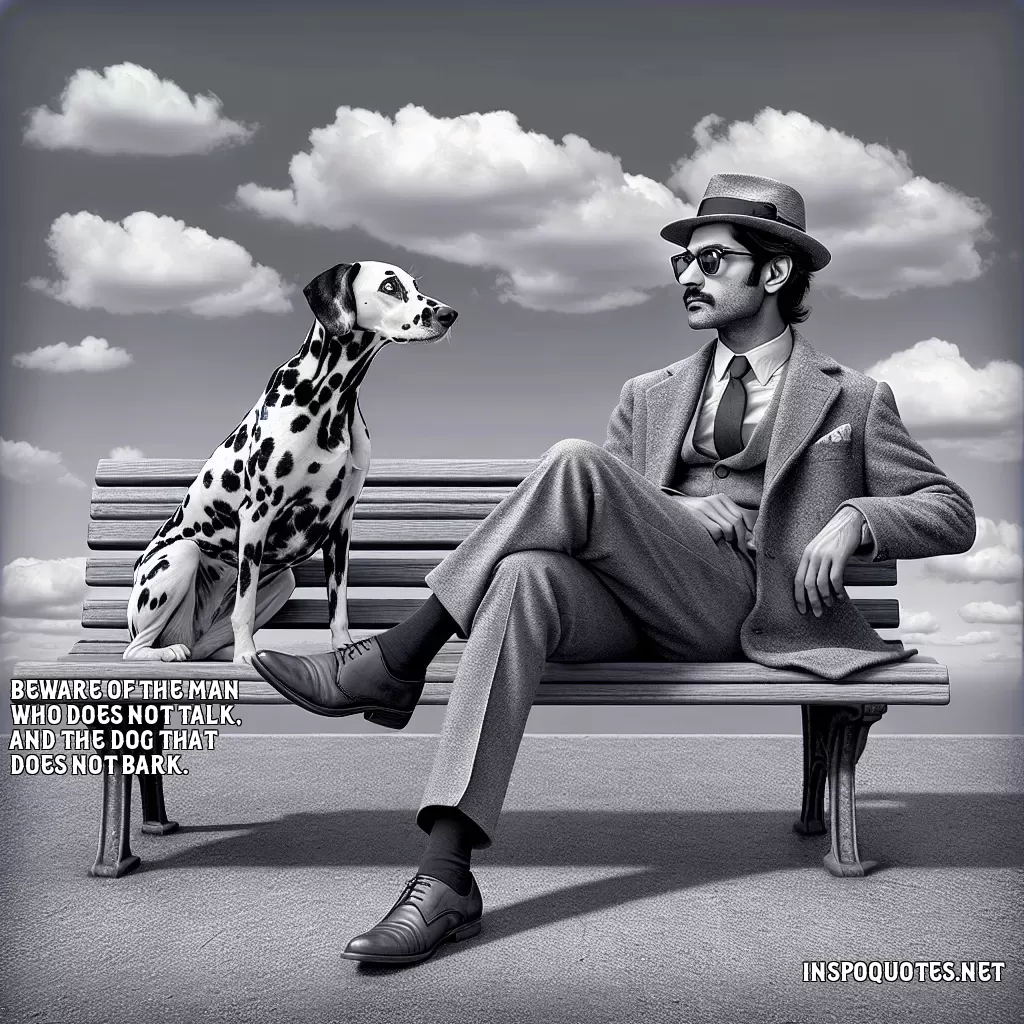
Beware of the man who does not talk, and the dog that does not bark.
Author: William S. Burroughs
👁️ 10 views

Beware of the man who does not talk, and the dog that does not bark.
👁️ 10 views
The quote "Beware of the man who does not talk, and the dog that does not bark" serves as a metaphorical warning about underestimating the silent or the seemingly passive. Both elements of the quote—the silent man and the quiet dog—highlight the concept that appearances can be deceiving, and that silence or a lack of action should not be equated with harmlessness or lack of power. People who do not talk much may possess a deep reservoir of thoughts, insights, or intentions. Silence can be a strategic tool, allowing individuals to absorb information, plan, and act at opportune moments. They might be more observant, discerning, and possibly more dangerous or influential than their more vocal counterparts. Their silence could indicate self-restraint, intelligence, or a strategic mind, requiring others to be cautious in how they interpret or engage with them. Similarly, the dog that does not bark can be seen as an unexpected threat. Typically, a barking dog serves as a warning, indicating danger, fear, or aggression. A dog that remains silent when it would be natural to bark might be more dangerous because its intentions are unclear, allowing it to act unpredictably. This reflects the broader idea that threats do not always manifest loudly or overtly; instead, they may lie hidden or reveal themselves only when it is advantageous. Overall, the quote cautions against complacency and urges vigilance. It suggests that understanding human behavior and situations often requires looking beyond the surface. Silent people or quiet scenarios could conceal complexity, and understanding their true nature involves attentiveness and discernment. Thus, the essence of the quote lies in encouraging a deeper scrutiny of the seemingly benign, emphasizing that true intentions or dangers may reside beneath silence.
Quote By: William S. Burroughs
**William S. Burroughs: A Literary Maverick**
William S. Burroughs, born on February 5, 1914, in St. Louis, Missouri, emerged as one of the most influential and controversial figures in American literature. He was the second of four sons in a well-to-do family; his grandfather, a prominent figure in the Burroughs Adding Machine company, helped establish the family’s wealth. Burroughs attended Harvard University, where he studied literature and developed a penchant for experimentation that would define his later work. This intellectual environment, combined with his family's legacy, set the stage for Burroughs' unique contribution to the literary world.
Burroughs is best known for his groundbreaking novel, "Naked Lunch," published in 1959. The book, notorious for its non-linear structure and graphic content, was initially banned in several cities due to its controversial subject matter. However, it went on to gain critical acclaim and is now considered a classic of modern literature. The narrative style of "Naked Lunch," with its fragmented prose and hallucinatory imagery, reflects Burroughs' own tumultuous life filled with drug addiction, exploration of sexuality, and his experiences with the counterculture movement of the 1950s and 60s. Burroughs' exploration of these themes marked a departure from traditional storytelling, influencing a generation of writers and artists.
Throughout his life, William S. Burroughs continually reinvented himself and his work. His interest in different forms of media led him to delve into the world of visual arts, sound recordings, and even film, collaborating with notable figures such as David Cronenberg and Brion Gysin. Burroughs became synonymous with the Beat Generation, often associated with contemporaries like Jack Kerouac and Allen Ginsberg, although his style was markedly distinct and avant-garde.
Despite the challenges of his personal life, including struggles with addiction and grief over the accidental death of his wife, Burroughs maintained a prolific writing career until his passing on August 2, 1997. His legacy endures through his influential works and the radical ideas he championed, making William S. Burroughs a defining voice in 20th-century literature. His bold approach to narrative, form, and content continues to inspire writers and artists today, cementing his status as a literary maverick.